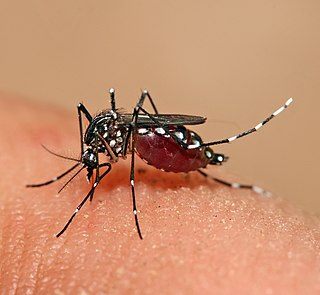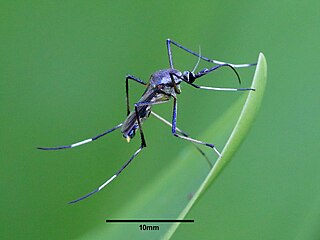
Aedes albopictus, from the mosquito (Culicidae) family, also known as (Asian) tiger mosquito or forest mosquito, is a mosquito native to the tropical and subtropical areas of Southeast Asia. In the past few decades, however, this species has spread to many countries through the transport of goods and international travel. It is characterized by the white bands on its legs and body.

Aedes is a genus of mosquitoes originally found in tropical and subtropical zones, but now found on all continents except Antarctica. Some species have been spread by human activity: Aedes albopictus, a particularly invasive species, was recently spread to the New World, including the United States, by the used-tire trade.

Aedes aegypti, the yellow fever mosquito, is a mosquito that can spread dengue fever, chikungunya, Zika fever, Mayaro and yellow fever viruses, and other disease agents. The mosquito can be recognized by white markings on its legs and a marking in the form of a lyre on the upper surface of its thorax. This mosquito originated in Africa, but is now found in tropical, subtropical and temperate regions throughout the world.

The Culicinae are the most extensive subfamily of mosquitoes (Culicidae) and have species in every continent except Antarctica, but are highly concentrated in tropical areas. Mosquitoes are best known as parasites to many vertebrate animals and vectors for disease. They are holometabolous insects, and most species lay their eggs in stagnant water, to benefit their aquatic larval stage.
Philip James Barraud (1879–1948) was an English entomologist who specialised in mosquitoes. He worked in Iraq and India where he invented the Barraud cage for the transport and study of live mosquitoes. Barraud described many new genera and species of Culicidae. His collection, which included Palearctic Lepidoptera is in the Natural History Museum. The genus Barraudius Edwards, F.W., 1921 is named for him.

Ochlerotatus is a genus of mosquito. Until 2000, it was ranked as a subgenus of Aedes, but after Reinert's work, the clade was upgraded to the level of a genus. This change has resulted in the renaming of many subgenus species, and many aedini-related taxa are undergoing taxonomic revisions. Some authors are still using traditional taxonomic names in their publications.

Aedes pembaensis is a mosquito.

Aedes canadensis, the woodland pool mosquito, is an aggressive, day biting mosquito that can be a vector of a number of diseases which is found mainly in eastern North America.
Aedes australis is a brackish water mosquito species from the genus Aedes subgenus Halaedes. This was first confronted in New Zealand in 1961.
Aedes africanus is a species of mosquito that is found on the continent of Africa with the exclusion of Madagascar. Aedes aegypti and Aedes africanus are the two main yellow fever vector species in Zambia. Aedes africanus is mainly found in tropical forests not near wetlands.
Fredwardsius is a subgenus of the genus Aedes with distribution in southern Europe, southern Asia, and Africa. The subgenus was erected in 2000 after a comparison of specimens of Aedes vittatus with all other recognized genera and subgenera in the mosquito tribe Aedini indicated that the species had sufficiently unusual and unique morphological and other features of subgeneric rank significance to merit stand-alone status. Aedes vittatus was established as the type species, and is currently (2016) the only species in the subgenus, making Fredwardsius a monotypic genus.

Toxorhynchites speciosus is a mosquito species in the genus Toxorhynchites found in Australia.

Aedini is a mosquito tribe in the subfamily Culicinae. It is the main tribe of mosquitoes with 1256 species classified in 81 genera and two groups incertae sedis.
Aedes (Finlaya) chrysolineatus is a species complex of zoophilic mosquito belonging to the genus Aedes. It is found in Sri Lanka, India, Japan, Malaya, Thailand, Indochina, Sumatra, and Java.
Aedes (Stegomyia) krombeini is a species complex of zoophilic mosquito belonging to the Scutellaria group of the genus Aedes. It is endemic to Sri Lanka.
Aedes (Paraedes) ostentatio is a species complex of zoophilic mosquito belonging to the genus Aedes. It is found in Sri Lanka, Malay, India, Indochina, Indonesia, Philippines, Laos, Thailand, Vietnam and Maluku.
Aedes scatophagoides is a species complex of zoophilic mosquito belonging to the Mucidus Group of the genus Aedes.
Toxorhynchites (Toxorhynchites) splendens is a species of non-hematophagous mosquito belonging to the genus Toxorhynchites. It is widely used as a predator to control dengue mosquitoes.
Aedes scapularis is a species of mosquito primarily found in neo-tropical regions of the Americas.








